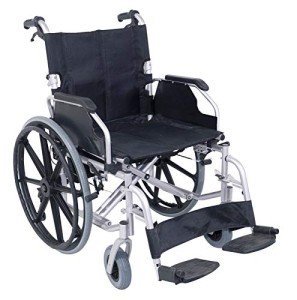Bariatric Transit 24 Inch Wheelchair
A bariatric wheelchair is perfect if you need a chair with a bigger seat width and higher weight capacity. This resilient wheelchair has a nylon padded seat that extends 24 inches large with swing-away footrests. a cool way to improve has significant 4 caster mobility and attendant locks for safe stops. The heavy-duty slide tube frame can support up to 450 pounds.
Weight Capacity

When choosing a wheelchair for yourself or for an enjoyed one, it is essential to think about the weight capacity. Standard wheelchairs can accommodate as much as 250 pounds, however bariatric chairs have the ability to support approximately 700 pounds. This distinction in capacity is the main factor that bariatric wheelchairs are stronger and heavier than basic designs.
To assist motorists securely transport passengers who use bariatric wheelchairs, it is vital to have cars geared up with appropriate equipment. This consists of wheelchair lifts and ramps that can deal with the increased size and weight of the chair. Additionally, drivers ought to receive training on how to steer these large mobility aids.
The Medline folding extra large bariatric transport wheelchair has a large 24" seat and a carbon steel frame with rust- and chip-resistant chrome plating. It also features easy-to-clean vinyl upholstery and swing-away footrests with a push-button adjustable height function. This heavy-duty wheelchair has a weight capacity of 500 pounds.
When selecting a wheelchair, it is essential to request recommendations from a doctor or mobility professional. They can assess your physical condition and recommend the best mobility service for you. They can also assist you figure out if Medicare or personal insurance covers the expense of your wheelchair.
Wheelchair Frame
A wheelchair frame is the primary assistance system that holds the other components of the chair. The frames are made from a range of products, consisting of aluminum, titanium, and carbon fibre. Rigid manual wheelchairs are designed with efficiency in mind and use the principles of sports bike frames-- triangles are one of the greatest shapes readily available and engineers have used this knowledge to develop frames that create a stiff system that utilizes less energy for propulsion than more versatile frames.
The choice of wheelchair frame is often based upon the needs and top priorities of the customer as assessed by their OT/PT or other clinician. For instance, a front frame angle is a crucial setup as it impacts how well the client can move or self-catheterize. Also the seat to footplate height is an important aspect for positioning and balance.
Many wheelchairs have the alternative to be configured with a fixed or reclining frame. For those who need a more steady chair for stability or for transport in vehicles, a fixed frame is best. This is specifically true for those who require a bariatric chair with a wider seat width or higher weight capacity.
Folding frames have a traditional "cross-brace" or X style that enables the chair to fold by bringing the side rails together, although there are other styles readily available for folding chairs, such as a scissor brace frame (Kuschall Champion) which reduces the variety of moving parts and for that reason can be lighter than the cross-brace styles. Other alternatives for folding frames consist of swing-away legrests and removable arms.
Many manufacturers also provide a variety of options for the wheelchair frame front end, such as the frame angle. A 90 degree frame angle places the feet at a natural position for pressing, while a 75 degree frame angle positions the feet more forward. bariatric mobility equipment of frame angle should be carefully thought about as the more forward position might make it tough for the wheelchair user to get over obstacles or may cause a wheel capturing on dropped curbs and producing vibration.
Rigid frames are typically made from aluminium, although some designs have a dual tube construction that is comparable to the sport frames used in cycling, to assist increase strength and stability. Carbon Fibre is another product utilized in the frame building and construction of some wheelchairs, providing an even stiffer and lighter frame.
